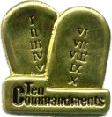 [Note the onstage banners.] What are these? They are the Ten Commandments, but they are also not the Ten Commandments. The Ten Commandments as we often think of them are a symbol. They are a part of our culture, history, and heritage.
[Note the onstage banners.] What are these? They are the Ten Commandments, but they are also not the Ten Commandments. The Ten Commandments as we often think of them are a symbol. They are a part of our culture, history, and heritage.
Religious Symbol: The two tablets and the ten numbers are an icon. They are a religious icon perhaps as prominent as the Christian Cross and the Star of David. That icon can be crafted into jewelry, monuments, paperweights, plaques. It is often regarded as a faith symbol and both the Jewish and Christian traditions hold the concept of the Ten Commandments in high esteem

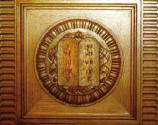
Legal Symbol: Of course the Ten Commandments are not strictly a religious/faith symbol. They are also regarded as representational of legal and civic virtues. They are regarded as the foundation of law. Thats why the image of Moses and the Ten Commandments is above the entrance of the U.S. Supreme Court. And you will also find a symbol of the Ten Commandments engraved on the doors to the Supreme Court. Many of building in Washington DC feature this symbol as a basis of good society, legal foundation, and civil law.

 But the distinction between the Commandments as religious and legal is somewhat confusing. Thats why displays of the Ten Commandments have been controversial. The most notable of these centered on the 5000 lb. monument that Judge Roy S. Moore had placed in the Alabama Supreme Court. He was ordered to remove it. He didnt. So the Federal District Judge had it removed. There was a lot of protest and prayer and even though some like Ken Barnett yelled PUT IT BACK and GET YOUR HANDS OFF MY GOD, they took the monument out. It just goes to show how much of an impact this symbol has.
But the distinction between the Commandments as religious and legal is somewhat confusing. Thats why displays of the Ten Commandments have been controversial. The most notable of these centered on the 5000 lb. monument that Judge Roy S. Moore had placed in the Alabama Supreme Court. He was ordered to remove it. He didnt. So the Federal District Judge had it removed. There was a lot of protest and prayer and even though some like Ken Barnett yelled PUT IT BACK and GET YOUR HANDS OFF MY GOD, they took the monument out. It just goes to show how much of an impact this symbol has.
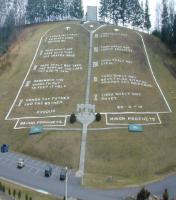

And even though they took the monument out of the Alabama Supreme Court, monuments like the one in the Texas Capitol are pretty common. And there are of course private displays like the worlds largest Ten Commandments in western North Carolina. (And have you noticed the billboard on I-40 when you come into Arkansas from Oklahoma?)
Shorthand for Basic Rules: The Ten Commandments is shorthand for basic rules. Searching through an on-line bookshop I found that there are books titled The Ten Commandments of ... dating, marriage, self-esteem, professionalism for teachers, mindpower golf, making money, and for cycling (but it was called the Ten-Speed Commandments.) Isnt it interesting that we regard the Ten Commandments of something as the basic rules or complete guide to a subject. Why is that?
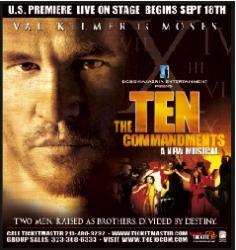 Cultural Phenomenon: The Ten Commandments have been around for over 3,000 years and this simple collection of virtues and laws and the story behind them has inspired drama. Did you know that theres a musical based on the Ten Commandments?
Cultural Phenomenon: The Ten Commandments have been around for over 3,000 years and this simple collection of virtues and laws and the story behind them has inspired drama. Did you know that theres a musical based on the Ten Commandments?
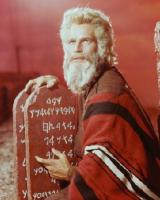
In 1989 a Polish filmmaker produced a 10 part series on the Ten Commandments. Short dramatic films based on the concepts. And of course, most people think of Charleton Heston. What would Easter be without "The Ten Commandments" on TV?
Thats what we think of. Thats what comes to mind. Ten Rules, Ten Laws, Ten Commandments. A plaque, a monument, a movie. But is that really what the Ten Commandments are? Where are they found in the Bible. How are they presented there?
It may surprise us to compare the typical form of their display with the texts that actually introduce the words that have come to be known as the Ten Commandments. These words are found in their earliest form in Exodus 20. Read the text ...
Reading through this text makes us recognize some important facts to understanding what the Ten Commandments are really all about ...
 Link to next sermon
Link to next sermon
 Link to other sermons of Chris Benjamin
Link to other sermons of Chris Benjamin